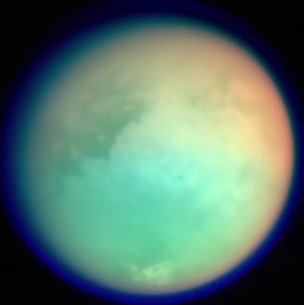(单词翻译:单击)
We've toured a lot of the worlds in our solar system here on SciShow Space.
我们在“太空科学秀”节目中参观了太阳系的很多世界。
Most of the time, the visit hasn't ended well, other planets and moons tend to be uninhabitable.
大多数时候,参观结果并不好,其他行星和卫星往往不适宜居住。
But today we're visiting someplace a little more friendly, Saturn's largest moon, Titan,
但今天我们要去拜访一个更友好的地方,土星最大的卫星——土卫六,
which is one of the most Earth-like worlds in the solar system or olden-day Earth-like anyway.
它是太阳系最像地球的天体之一或者说是昔日类似地球的卫星。
That's because Titan has a dense atmosphere of nitrogen and methane,
这是因为土卫六有由氮和甲烷构成的稠密大气,
which is probably close to what Earth's atmosphere was like more than 3.5 billion years ago,
它与35亿年的地球大气
before cyanobacteria started pumping oxygen into our atmosphere.
即在蓝藻细菌开始注入氧气之前的大气很接近。
When the European Space Agency's Huygens probe landed in 2005,
当欧洲太空总署的“惠更斯”号探测器于2005年着陆时,
it was humanity's first landing on any body in the outer solar system.
标志着人类首次在外太阳系的天体上着陆。
Titan's around 1.5 billion kilometers from the sun.
土卫六与太阳相距15亿公里,
That's a lot farther than Earth's 150 million kilometers, so it's cold and dark.
这比日地距离1.5亿公里远得多,所以它又冷又暗。
It's also almost impossible to see Titan's surface through that thick, orange atmosphere.
而且透过厚厚的橙色大气层看其表面也不太可能。
The atmosphere is more than just dense, it's also huge, stretching 600 kilometers above Titan's surface.
土卫六的大气层不仅仅稠密,而且庞大,能从它表面延伸至600公里的位置。
That's even higher than Earth's 480 kilometer atmosphere,
这要比地球480公里宽的大气高得多,
even though Earth itself is more than twice the size of Titan.
即使地球的体积是它的2倍多。
That's because Titan's gravity is weaker, about 14 percent of Earth's,
这是因为土卫六的引力弱,仅有地球的14%,
so its atmosphere doesn't cling as tightly as ours.
所以它的大气不能像地球大气那样紧密吸附。

Because other moons don't really have dense atmospheres,
因为其他卫星没有稠密大气,
astronomers used to think to figure out how big Titan was,
天文学家们过去想弄清楚土卫六的体积,
they could just measure the big blob they were seeing through their telescopes.
可以通过望远镜观察到的一大团来测量。
And by those numbers, it seemed to be the solar system's largest moon.
这些数据表明它似乎是太阳系最大的卫星。
Then, in 1980, Voyager 1 did a flyby and discovered the moons huge atmosphere.
随后在1980年,“旅行者1号”做了一次飞近探测,发现了卫星的庞大大气层。
Why does Titan have an atmosphere while other large planet-sized moons like Jupiter's Ganymede and Callisto don't?
为什么土卫六有大气层而其他行星大小的卫星,如木星的木卫三和木卫四没有?
Well, astronomers don't know for sure.
天文学家也不确定。
Astronomers think that Titan's atmosphere seems to come from gases released from inside the moon.
他们认为土卫六的大气层似乎来自卫星内部释放的气体。
It might have more of the stuff than other moons do because more of it was trapped inside when Titan formed,
它似乎比其他卫星上的多,因为它在土卫六形成时就被困住很多,
but we don't really know why Titan was the lucky one.
但我们真不知道土卫六为什么这么幸运。
That's just one of the unsolved mysteries about Titan,
这是土卫六的一个未解之谜,
and as we close in on the moon's surface, we'll spot another: the methane clouds.
在我们靠近它的表面时,发现了另一个谜题:甲烷云。
They're a lot like Earth's clouds, in the sense that they go through a cycle that's mostly driven by sunlight.
它们很像地球的云,从某种意义上说,它们经历的循环是由太阳光驱动的。
But instead of water, they come from the liquid methane on Titan's surface.
但它们不是水,而是来自土卫六表面的液态甲烷。
On Earth, methane is almost always a gas.
在地球上,甲烷几乎都是气体。
But on average, it's -179℃ on Titan's surface, which is why methane's a liquid or solid.
但土卫六表面的平均温度是-179℃,这就是为什么它是液体或固体。
So, the methane on Titan's surface evaporates, condenses into clouds,
于是土卫六表面的甲烷蒸发,凝结成云,
and falls back to the ground as methane rain, starting the process all over again.
下雨时落到地面上,重新开始这个过程。
Except, the same sunlight that keeps the methane clouds going should be destroying them.
但是,驱动甲烷循环的阳光也会破坏甲烷云。
The sun's radiation should be breaking down Titan's methane molecules while they're in the clouds,
太阳辐射会在云层中分解土卫六的甲烷分子,
so some process must be replacing them.
所以一定有某些过程代替了它们。
We just don't know exactly what.
只不过我们不知道具体是什么。
Using our probe to look out over Titan's surface, we'd see lakes, rivers and seas.
我们利用探测器看土卫六的表面,能看到湖泊、河流和大海。
Even though they're made of methane, Titan is the only world in the solar system other than Earth
即使它们是由甲烷构成的,土卫六仍是除了地球之外唯一一个
that we know has these big collections of stable liquid on its surface.
表面有大量稳定液体的天体。
And since conditions on Titan are close to methane's freezing point,
因为土卫六的环境接近甲烷冰点,
we'd also see solid methane, in the form of dunes and hills of rocky ice,
所以我们也能看到液态甲烷,它们以沙丘和落基冰丘的形式出现,
showing signs of erosion from wind and rain.
展示着风雨侵蚀的痕迹。
But there are a few things we don't know if we'd see on the moon.
但有几样东西我们不知道能否在土卫六上看到。
For example, researchers think Titan might have cryovolcanoes,
例如,研究人员认为土卫六可能有冰火山,
volcanoes that erupt compounds like methane instead of molten rock.
它们会喷发出甲烷这样的化合物,而不是熔化的岩石。
That would help free methane from under the moon's surface,
这有助于释放卫星表面下的甲烷,
which might be what's replenishing the methane the sun destroys.
可能会补充太阳破坏的甲烷。
And if we could burrow under the ice on Titan's surface, we might also find huge oceans.
如果我们能在土卫六表面的冰下挖洞,就可能找到大洋。
As Titan orbits Saturn, the planet's gravity pulls on the moon unevenly,
由于土卫六围着土星旋转,行星引力不均匀地拉着卫星,
making the moon's insides move around.
使得卫星内部来回晃动。
The heat from all that friction might make it warm enough for there to be liquid sloshing around under Titan's hard surface.
所有摩擦产生的热量可能会使它变得足够温暖,使其液化,在土卫六坚硬的表面下流动。
So, researchers still have a lot of questions about this huge, weird moon.
因此,研究人员仍对这颗奇怪的巨大卫星有很多疑问。
Hopefully, more clues from telescopes, the Cassini probe, and the Huygens lander will help answer some of them.
值得期待的是,更多望远镜、“卡西尼”号探测器、“惠更斯”探测器带来的线索会帮助我们解答一些问题。
Thanks for watching this episode of SciShow Space,
感谢您收看本期的太空科学秀,
which was brought to you by our awesome patrons on Patreon.
本栏目是由Patreon大力赞助的。
If you want to help us keep making episodes like this, just go to patreon.com/scishow.
如果你想帮助我们继续制作此类节目,就登陆patreon.com/scishow吧!


